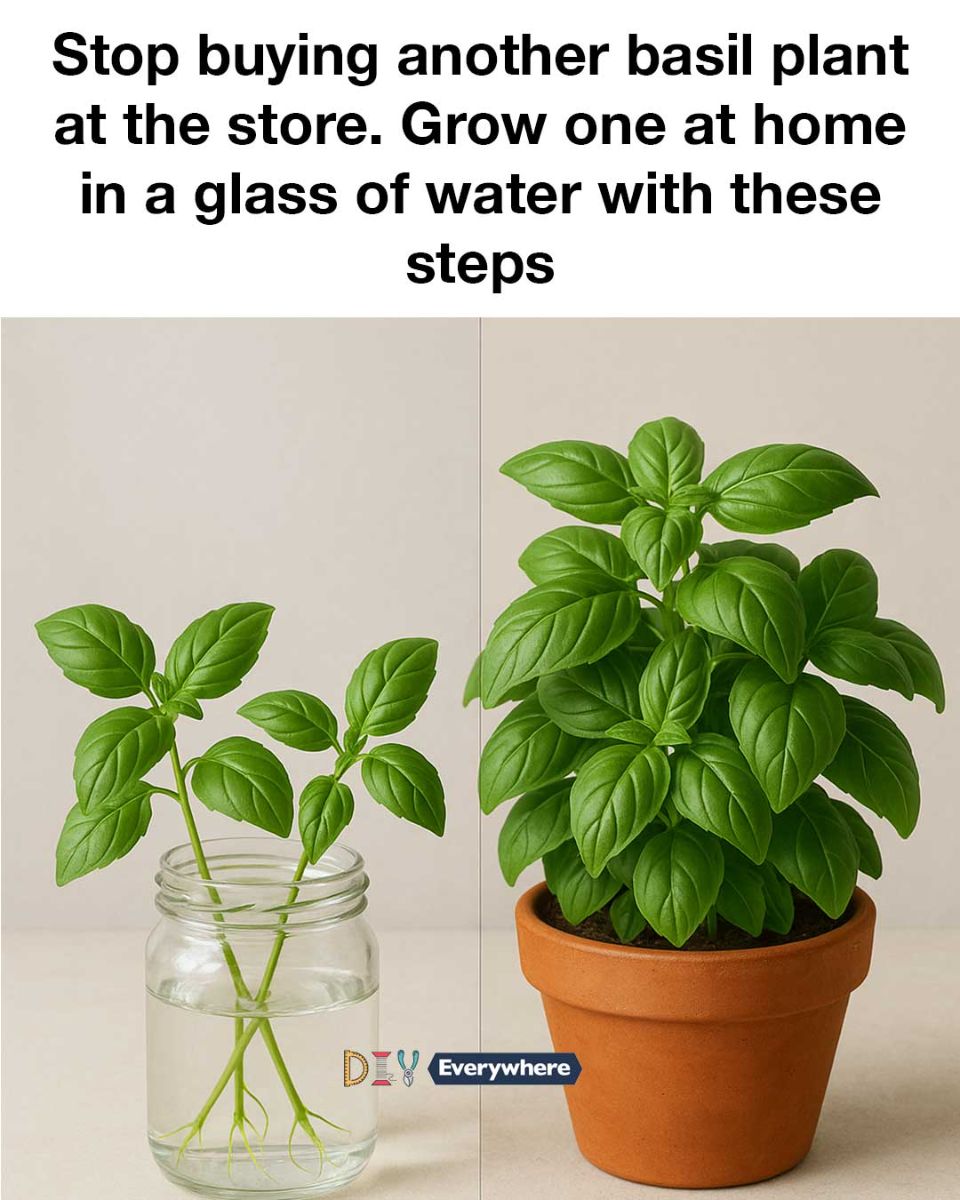Stop buying another basil plant at the store. Grow one at home in a glass of water with these steps
Basil is a beloved herb, cherished for its aromatic leaves and versatile culinary uses. Whether you’re adding it to a fresh Caprese salad or infusing it into a homemade pesto, basil brings a burst of flavor to any dish. However, buying basil plants from the store can be costly and often disappointing, as they tend to wither quickly without proper care.
Fortunately, growing basil at home is not only cost-effective but also incredibly rewarding. With just a few simple steps, you can cultivate your own basil plant in a glass of water, ensuring a fresh supply of this delightful herb right at your fingertips. This method of hydroponic gardening is perfect for those with limited space or who want to avoid the mess of soil-based planting.
1. Why Growing Basil at Home Is a Game Changer
Growing basil at home offers numerous advantages over purchasing it from the store. First and foremost, it is significantly more economical. A single basil plant can cost anywhere from $3 to $5 at a grocery store, and these plants often have a short lifespan. By growing your own, you can have a continuous supply of basil for a fraction of the cost.
Moreover, homegrown basil is fresher and more flavorful. Store-bought basil may have been harvested days before reaching the shelves, losing some of its aromatic oils in the process. When you grow basil at home, you can harvest it at its peak, ensuring maximum flavor and aroma.
2. The Benefits of Hydroponic Herb Gardening
Hydroponic gardening, or growing plants in water without soil, offers several benefits. It is a clean and space-efficient method, ideal for indoor gardening. Without the need for soil, there’s no mess, and you can easily monitor the plant’s root health.
Additionally, hydroponic systems can lead to faster growth rates. Since the roots are directly exposed to water and nutrients, they can absorb them more efficiently, leading to quicker development. This means you can enjoy your homegrown basil sooner than with traditional soil planting.
3. Choosing the Right Basil Variety for Water Growth
When selecting a basil variety for water growth, it’s important to consider the plant’s size and growth habits. Sweet basil (Ocimum basilicum) is a popular choice due to its classic flavor and adaptability to hydroponic systems. Other varieties like Genovese or Thai basil can also thrive in water.
Consider the space you have available and the flavor profile you desire. Smaller varieties like Greek basil are perfect for compact spaces, while larger varieties may require more room to grow.
4. Essential Supplies You’ll Need to Get Started
To start growing basil in water, you’ll need a few basic supplies. First, select a clear glass or jar, which will allow you to monitor root development. You’ll also need a pair of sharp scissors or pruning shears to take cuttings from an existing basil plant.
Additionally, consider using a liquid plant food or hydroponic nutrient solution to provide essential nutrients. While basil can grow in plain water, a nutrient solution will promote healthier and more robust growth.
5. Step-by-Step Guide to Preparing Your Basil Cutting
Begin by selecting a healthy basil plant with vibrant green leaves. Using sharp scissors, cut a 4-6 inch stem just below a leaf node, where leaves attach to the stem. Remove the leaves from the bottom 2 inches of the cutting to prevent them from rotting in the water.
Place the cutting in a glass of water, ensuring that the leaf nodes are submerged. These nodes will develop roots, so it’s crucial they remain underwater. Position the glass in a warm, sunny spot to encourage root growth.
6. How to Properly Place Your Basil in Water
Once your cutting is prepared, place it in a glass of water with the cut end submerged. Ensure that the glass is tall enough to support the cutting and prevent it from tipping over. It’s important to change the water every few days to prevent stagnation and promote healthy root development.
As the cutting begins to root, you may notice small white roots emerging from the leaf nodes. This is a sign that your basil is thriving and will soon be ready for harvesting.
7. Optimal Light Conditions for Basil Growth
Basil thrives in bright, indirect sunlight. Place your glass of basil cuttings near a south-facing window where it can receive 6-8 hours of light per day. If natural light is limited, consider using a grow light to supplement the plant’s needs.
Be mindful of temperature fluctuations, as basil prefers a consistent environment. Avoid placing the plant near drafts or heat sources, which can stress the plant and hinder growth.
8. Maintaining Water Quality for Healthy Basil
Maintaining clean water is crucial for the health of your basil plant. Change the water every 3-4 days to prevent the growth of algae and bacteria. If using tap water, let it sit for 24 hours before adding it to the glass to allow chlorine to dissipate.
Consider adding a small amount of liquid plant food to the water every two weeks to provide essential nutrients. Follow the manufacturer’s instructions for dilution rates to avoid over-fertilizing.
9. Recognizing and Addressing Common Growth Issues
Common issues with hydroponic basil include yellowing leaves, which can indicate nutrient deficiencies or poor water quality. Ensure that the plant is receiving adequate light and nutrients, and regularly change the water to prevent stagnation.
If you notice mold or algae growth, clean the glass thoroughly and trim any affected roots. Keeping the water fresh and the environment clean will help prevent these issues.
10. When and How to Harvest Your Basil
Once your basil plant has developed a healthy root system and new leaves, it’s ready for harvesting. Use sharp scissors to trim the stems just above a pair of leaves, which will encourage the plant to grow bushier.
Regular harvesting not only provides fresh basil for your kitchen but also promotes continued growth. Aim to harvest once the plant has at least 6-8 leaves, and avoid removing more than one-third of the plant at a time.
11. Creative Uses for Your Homegrown Basil
Homegrown basil can be used in a multitude of culinary applications. Add fresh leaves to salads, sandwiches, and pasta dishes for a burst of flavor. Basil can also be blended into pesto, infused into oils, or used to garnish cocktails.
Beyond the kitchen, basil’s aromatic properties make it a natural air freshener. Place a few sprigs in a vase to enjoy its fragrance throughout your home. With a little creativity, your homegrown basil can enhance both your meals and your living space.

